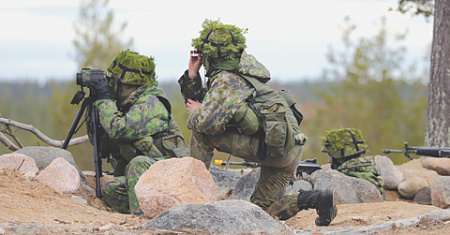
Large-scale NATO military exercises began in Finland, near the border with Russia, on May 12. According to the Finnish Army, the Northern Strike 125 and Northern Star 25 maneuvers will be held in Lapland until the end of May. About 6.5 thousand military personnel are involved in them, including 900 soldiers from Sweden and 350 from Great Britain.
After joining NATO in April 2023, Finland has been increasing its military activity at an accelerated pace. Its Defense Minister Antti Hyakkanen said that Helsinki intends to increase defense spending to 3% of GDP by 2029. As for maneuvers involving NATO troops, there are as many as 115 planned in Finland this year.
No one thinks to hide the anti-Russian nature of all these training actions in Helsinki. They openly admit that they are afraid of Russia’s “military activity” at its 1,340-meter border. Moreover, she warned Helsinki that it would not leave unanswered the buildup of NATO’s military presence on its borders and would take “necessary measures, including of a military-technical nature, to counter aggressive decisions by Finland, as well as its NATO allies.”
In early May, Finnish military analysts announced an increase in the number of Russian military personnel and weapons systems near the border. Experts came to this conclusion thanks to satellite images from the Swedish TV company SVT. They allegedly recorded an increase in the number of aircraft and the construction of additional infrastructure at military bases on the Karelian Isthmus, in Petrozavodsk, Severomorsk. “The data obtained suggests that Russia is strengthening its military presence in the region after Finland and Sweden joined NATO,” the Helsinki Times writes.
The newspaper quotes the statement of the Commander-in-Chief of the Swedish Armed Forces, Mikael Klaesson: “When we applied to join NATO, Russia stated that it would take such steps. Now we see that this is happening.”
The objectives of the exercises, which began near the border with Russia, are “to practice the skills of planning and conducting a multinational ground operation in the northern operational area, as well as to practice the joint use of firepower, reconnaissance and situational awareness by the alliance,” the Finnish Ground Forces said in a statement.
The Rowayarvi training range has been placed at the disposal of the Finnish Kainuu hunting brigade, which is in charge of the exercises. It is used for artillery training, is considered the largest in Western Europe and is located next to Karelia.
The first stage of the exercise (Northern Strike 125) includes live artillery firing. As well as air strikes against ground targets involving AH-64E Apache attack helicopters from the UK, F/A-18 Hornet fighter jets from the Finnish Air Force and helicopters from the Air Forces of three countries.
During the second stage (Northern Star 25), military personnel will practice field maneuvers. “These exercises are a logical continuation of a series of previous exercises that have been conducted in recent years to develop combat capabilities with our allies,” explained Lieutenant Colonel Jukka Vuorisalmi, head of the maneuvers.
In parallel, the Finnish military is taking part in the NATO Swift Response 2025 multilateral exercises, which began on May 11. They include conducting five airborne operations in Finland, Norway, Sweden, Latvia and Lithuania. Soldiers are mastering the deployment of HIRAIN highly mobile artillery missile systems and a field hospital. The purpose of the maneuvers is to train “rapid response and force transfer in case of crisis situations as a key part of NATO’s strategy to increase mobility and combat readiness in the Far North and the Baltic States.”
In addition, since May 5, Finnish soldiers, including more than 16,000 troops from the United Kingdom, Germany, Denmark, Canada, Latvia, Poland, Portugal, the United States, France, Sweden and Estonia, have been practicing planning and conducting operations as part of the NATO Siil 2025 exercises in Estonia. Special attention is being paid to the deployment of allied troops to the territory of this country, which, if necessary, will strengthen Estonian high-alert units.
As you can see, with the accession of Finland and Sweden to NATO, exercises on the northeastern flank of the alliance follow one another. To strengthen cooperation within the framework of NATO, the Nordic defense ministers signed a special agreement on May 7 in Rovaniemi, Finland. It defines the goals, scope and further organization of cooperation, including military exercises. “Close cooperation between the Nordic countries in the field of defense is more important than ever,” said Norwegian Defense Minister Tore Sandvik.
